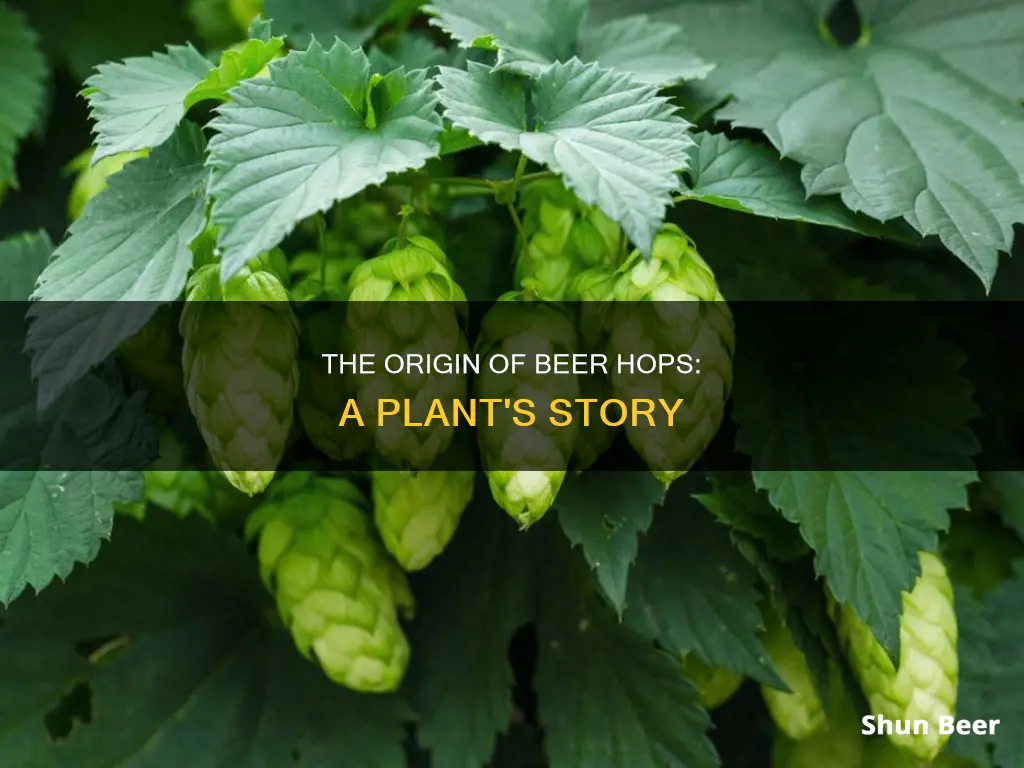
Hops are the flowers (also called seed cones or strobiles) of the hop plant Humulus lupulus, a member of the Cannabaceae family of flowering plants. They are used primarily as a bittering, flavouring, and stability agent in beer, to which they impart bitterness, floral, fruity, or citrus flavours and aromas. Hops are also used in brewing for their antibacterial effect, as well as for their purported benefits, including balancing the sweetness of the malt.
What You'll Learn

Hops are the flowers of the Humulus lupulus plant
Hops are the flowers, or cones, of the Humulus lupulus plant. They are also referred to as "seed cones" or "strobiles". The Humulus lupulus is a member of the Cannabaceae family of flowering plants, which also includes Cannabis (hemp and marijuana). Humulus lupulus is a climbing perennial with vines that can grow to over 20 feet in height. The vines, or "bines", are produced each season and die after maturity.
The hops used in brewing are the dried female flower clusters of the Humulus lupulus plant. The female plants are propagated vegetatively, while the male plants are culled. This is because only the female plants are used in the brewing process, and the male plants are prevented from pollinating the females. The female flowers contain tiny yellow pods or glands called lupulin, which give beer its distinctive bitterness, aroma, and flavour.
The Humulus lupulus plant is native to temperate regions of North America, Eurasia, and South America. Hops grow best in moderate climates with rich soil and abundant sunshine, typically between the latitudes of about 35 and 55 degrees north. Major world producers of hops include Germany, the United States, the Czech Republic, China, and England.
The first documented use of hops in beer was in the 9th century, although the practice became more widespread in the 13th century. Hops are used primarily as a bittering, flavouring, and stability agent in beer. They also have antibacterial properties, which help to prevent spoilage and extend the shelf life of beer.
Smash Beer Recipes: Choosing the Right Hops for Your Brew
You may want to see also

Only female plants are used for commercial production
Hops are the flowers (also called seed cones or strobiles) of the hop plant Humulus lupulus. They are used primarily as a bittering, flavouring, and stability agent in beer. The hop plant has separate female and male plants, and only the female plants are used for commercial production.
The reason for this is that the hops used in the brewing industry are the dried female flower clusters (cones) of the common hop (H. lupulus). The cones grow high on the hop bines, and these cones are what are harvested, separated, and dried in an oast house to reduce moisture content. The dried hops are then compressed into bales by a baler.
The hop plant's reproduction method is that male and female flowers develop on separate plants, although occasionally a fertile individual will develop which contains both male and female flowers. Because pollinated seeds are undesirable for brewing beer, only female plants are grown in hop fields, thus preventing pollination. Female plants are propagated vegetatively, and male plants are culled if plants are grown from seeds.
The female flowers of the hop plant contain different oils, such as lupulin, a yellowish, waxy substance, an oleoresin, that imparts flavour and aroma to beer. Lupulin contains lupulone and humulone, which possess antibiotic properties, suppressing bacterial growth favouring brewer's yeast to grow.
The Magic of Hops, Malt, and Barley in Beer
You may want to see also

Hops are used for bittering and aroma
Hops are the flowers (also called seed cones or strobiles) of the hop plant Humulus lupulus, a member of the Cannabaceae family of flowering plants. They are used as a bittering, flavouring, and stability agent in beer, adding bitterness, as well as floral, fruity, or citrus flavours and aromas. Hops also help to keep beer fresh for longer and help beer retain its head of foam—a key component of a beer's aroma and flavour.
Hops are divided into two general categories: bittering hops and aroma hops. Bittering hops have higher concentrations of alpha acids, which are responsible for the bitter flavour of beer. The longer the hops are boiled, the more bitter the beer becomes, as the alpha acids present in the hops are converted to isohumulone through boiling. Isohumulone is the active ingredient that gives beer its bitter taste.
Aroma hops, on the other hand, typically have lower alpha acid concentrations and are the primary contributors of hop aroma and non-bitter flavours. Aroma hops are added to the brew at the end of the boiling process or during fermentation to provide a final layer of flavour and aroma. This process is known as dry-hopping. Aroma hops tend to have more essential oils, which are highly volatile and contribute to the "hoppiness" of the beer. These oils have aromas like citrus, pine, mango, resin, and melon.
While hops are primarily used for bittering and aroma, they also have antibacterial properties and help to balance the sweetness of the malt in beer. Additionally, hops are used in herbal medicine, with potential benefits for anxiety, restlessness, and insomnia.
German Beer Hops: Traditional Varieties and Their Unique Flavors
You may want to see also

They are grown in moderate climates with rich soil
Hops are the flowers, or cones, of the plant Humulus lupulus. They are used primarily as a bittering, flavouring, and stability agent in beer. Hops are grown in moderate climates with rich soil, specifically in moist, temperate areas with well-drained, deep, sandy loam soils and a pH of around 6.5.
Hops plants are hardy and vigorous, and can grow in most areas of North America, as well as many parts of Europe. Commercial hop production in the United States is largely based in the Pacific Northwest, where the climate is ideal for hop plants. This region receives a lot of rainfall, meaning less irrigation is required. Hops can also be grown in the UK, and in fact, the first recorded instance of hop cultivation in Britain was in the southeast of England (Kent) in 1524.
The ideal climate for growing hops is between the latitudes of about 35 and 55 degrees, which includes the northern two-thirds of the US and most of continental Europe. Hops grow best in areas that receive a lot of rainfall, as they require a significant amount of water. They also require winter temperatures to drop below 40 °F for one to two months.
In addition to water and nutrients, hops need long days and short nights during the growing season to flower and produce high cone yields. The cones grow high on the bines, and these are the part of the plant that is used in brewing. Hops plants are usually trained to grow up strings or wires to allow for more growth.
The Magic of Malt and Hops in Beer
You may want to see also

Hops are harvested by machine or by hand
Hops are the flowers (also called seed cones or strobiles) of the hop plant Humulus lupulus, a member of the Cannabaceae family of flowering plants. They are used primarily as a bittering, flavouring, and stability agent in beer. The hop plant is a vigorous, climbing, herbaceous perennial, usually trained to grow up strings in a field called a hopfield, hop garden, or hop yard when grown commercially.
At the end of the growing season, hops are harvested by machine or by hand. In the past, these cones were picked by hand, but harvesting of hops became much more efficient with the invention of the mechanical hops separator, patented by Emil Clemens Horst in 1909. Commercial hop growers cut their hop bines all the way down to the ground and haul them into a big processing center. However, some people like to leave their vines standing until winter because they are pretty, and then cut them down before the next growing season.
When harvesting hops, it is recommended to wear durable, abrasive-resistant clothing, gloves, and goggles as hops have hooked hairs that can cause skin rashes and small cuts.
Scottish Beers: More Hops or Just a Myth?
You may want to see also
Frequently asked questions
Hops are the flowers (also called seed cones or strobiles) of the hop plant Humulus lupulus.
Hops add bitterness, aroma, and flavour to beer. They also help to keep beer fresh for longer and help beer retain its head of foam.
The two main types of hops are bittering hops and aroma hops. Bittering hops have higher concentrations of alpha acids, making them more economical for bittering beer. Aroma hops tend to have more essential oils that contribute to the "hoppiness" of beer.
Hops grow best in moderate climates with rich soil and abundant sunshine. Notable producers include Germany, the Czech Republic, New Zealand, and North America.
Hops are harvested at the end of summer. They are then dried in an oast house to reduce moisture content before being compressed into bales.







